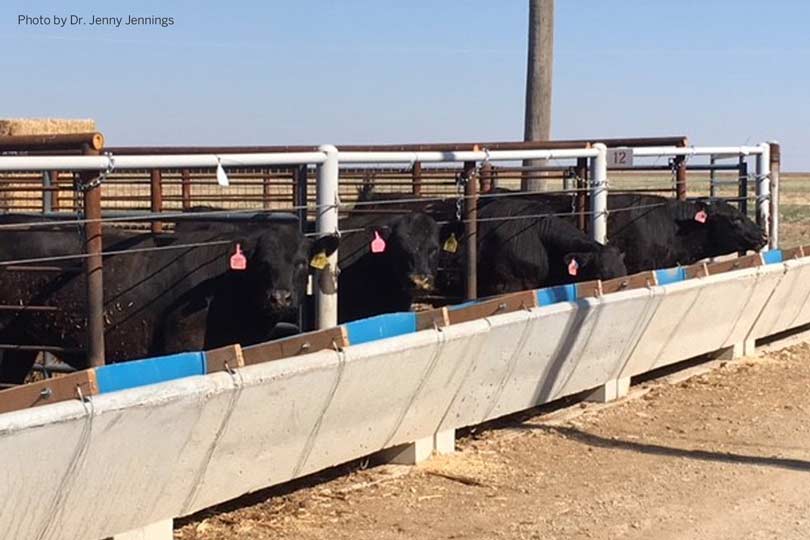By Jessica Domel
Multimedia Reporter
A naturally occurring toxin occasionally found in corn around the world may not be detrimental in beef cattle diets as previously thought.
Dr. Jenny Jennings, Texas A&M AgriLife Research beef nutritionist in Amarillo, fed 49 steers a dry, rolled corn-based finishing diet with increasing levels of fumonisin to determine the dangers of mycotoxin in feed corn.
“We found there were no differences in performance and carcass characteristics,” Jennings said in an interview with the Texas Farm Bureau Radio Network. “Our original question was if increasing fumonisin levels in beef cattle diets would decrease intake. A lot of nutritionists were concerned that if fumonisin was in the diet that might be the culprit of decreasing intake, which would then affect performance.”
The corn used in the study had less than five parts-per-million total dietary fumonisin as a control. The rations included fumonisin rates at 15, 30, 60 and 90 parts-per-million with daily levels averaging between 8.1 parts-per-million to 108.8 parts-per-million for 110 days before harvest.
After harvesting and processing, Jennings monitored the marbling score, ribeye, quality, yield grade and livers.
“We looked really closely at that and found there were no differences in intakes and other performance parameters,” Jennings said. “Carcass characteristics were similar, as well.”
The U.S. Food and Drug Administration (FDA) set the amount of fumonisin allowed in corn and beef cattle feed diets in 2001.
“The state chemist was using those guidelines as far as the amount allowed in the corn and then allowed in the feed,” Jennings said.
No more than 60 parts-per-million of fumonisin are allowed in corn. Cattle feed may have no more than 30-parts-per-million.
“We tested all the way up to 90 and found no differences,” Jennings said. “Hopefully, that has supplied some relief to some of the feeders and the corn growers.”
The research has changed the view of the state chemist’s office. FDA is also reportedly considering the research and may update their guidelines.
“There was very limited information. If you read the review published by the FDA, they even say that we had very limited information to work with to set the guidelines,” Jennings said.
In the meantime, ranchers and feedlots must continue to follow FDA guidance and guidelines set by the state chemist.
A feedlot owner who asked Jennings if AgriLife Research could find more information on the effects of fumonisin in beef cattle diets inspired the study.
“The hard thing, and the reason why there wasn’t a lot of information available, is fumonisin is variable,” Jennings said. “It’s a natural toxin in the corn. It’s not something from a research standpoint I could control.”
Every batch of corn comes in with different levels of fumonisin.
“We had to find a source of corn that had the fumonisin levels in it, and then bagged it all at once at the feedlot, so we could control those levels during the research,” Jennings said. “That’s what made it so hard to find the information because of how hard it is to actually perform a research trial because of all the variability in the corn.”
Many individuals and organizations came together for the study, including an energy cooperative and nutrition-consulting firms.
“Pretty much every aspect of the feeding industry came together, as well as Texas Cattle Feeders and Texas Corn Producers,” Jennings said. “It was a variety of sponsors that came to get this done.”
Another trial may be needed but is currently undetermined at this point.
“We still have some diagnostics that we need to look into on the cattle so we get the full story, but the performance and intakes were the most important part of the research,” Jennings said. “We have that answer now, and then it’s really waiting on the FDA’s response to it to see if there is any updating for the guidelines.”
The research is specific to beef cattle.
“It’s been a direct impact on the industry,” Jennings said. “I’ve received a lot of positive responses.”
Fumonisin is a toxin produced by fusarium fungi. It’s a type of mold that can grow on corn in specific environmental conditions.
“In most cases, it’s going to be during harvest. The corn gets wet. We all know that when things get wet, mold ca

